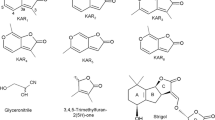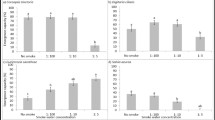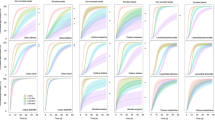Abstract
Some postfire annuals with dormant seeds use heat or chemical cues from charred wood to synchronize their germination with the postfire environment. We report that wood smoke and polar extracts of wood smoke, but not the ash of burned wood, contain potent cue(s) that stimulate germination in the postfire annual plant,Nicotiana attenuata. We examined the responses of seeds from six populations of plants from southwest Utah to extracts of smoke and found the proportion of viable seeds that germinated in the presence of smoke cues to vary between populations but to be consistent between generations. With the most dormant genotypes, we examine three mechanisms by which smoke-derived chemical cues may stimulate germination (chemical scarification of the seed coat and nutritive- and signal-mediated stimulation of germination) and report that the response is consistent with the signal-mediated mechanism. The germination cue(s) found in smoke are produced by the burning of hay, hardwood branches, leaves, and, to a lesser degree, cellulose. Moreover, the cues are found in the common food condiment, “liquid smoke,” and we find no significant differences between brands. With a bioassay-driven fractionation of liquid smoke, we identified 71 compounds in active fractions by GC-MS and AA spectrometry. However, when these compounds were tested in pure form or in combinations that mimicked the composition of active fractions over a range of concentrations, they failed to stimulate germination to the same degree that smoke fractions did. Moreover, enzymatic oxidation of some of these compounds also failed to stimulate germination. In addition, we tested 43 additional compounds also reported from smoke, 85 compounds that were structurally similar to those reported from smoke and 34 compounds reported to influence germination in other species. Of the 233 compounds tested, 16 proved to inhibit germination at the concentrations tested, and none reproduced the activity of wood smoke. By thermally desorbing smoke produced by cellulose combustions that was trapped on Chromosorb 101, we demonstrate that the cue is desorbed between 125 and 150°C. We estimate that the germination cues are active at concentrations of less than 1 pg/seed and, due to their chromatographic behavior, infer that a number of different chemical structures are active. In separate experiments, we demonstrate that cues remain active for at least 53 days in soil under greenhouse conditions and that the application of aqucous extracts of smoke to soil containing seeds results in dramatic increases in germination of artificial seed banks. Hence, although the chemical nature of the germination cue remains elusive, the stability of the germination cues, their water-solubility, and their activity in low concentrations suggest that these cues could serve as powerful tools for the examination of dormant seed banks and the selective factors thought to be important in the evolution of postfire plant communities.
Similar content being viewed by others
References
Barney, M.A., andFrischknecht, N.C. 1974. Vegetation changes following fires in the pinyonjuniper types of west-central Utah.J. Range Manage. 27:91–96.
Bewley, J.D., andBlack, M. 1982. Physiology and Biochemistry of Seeds. Springer-Verlag, Berlin.
Boodley, J. W., andSheldrake, R.J. 1977. Cornell peat-lite mixes for commercial plant growing. Cornell Information Bulletin 43.
Brits, G.J., Calitz, F.J., Brown, N.A.C. andManning, J.C. 1993. Desiccation as the active principle in heat-stimulated germination ofLeucospermum R. Br. (Proteaceae) in fynbos.New Phytol. 125:397–403.
Britton, C.M., andRalphs, M.H. 1978. Use of fire as a management tool in sagebrush ecosystems. The Sagebrush Ecosystem: A Symposium, Utah State University, College of Natural Resources, Logan, Utah.
Brotherson, J.D., Szyska, L.A., andEvenson, W.E. 1980. Poisonous plants of Utah.Great Basin Nat. 40:229–253.
Bye, R.A. 1972. Ethnobotany of the southern Paiute indians in the 1870's: With a note on the early ethnobotanical contributions of Dr. Edward Palmer, pp. 87–104,in D.D. Fowler (ed.). Great Great Basin Cultural Ecology: A Symposium. Reno and Las Vegas, Nevada.
Chang, M., andLynn, D.G. 1986. The haustorium and the chemistry of host recognition in parasitic angiosperms.J. Chem. Ecol. 12:561–579.
Chang, M., Netzly, D.H., Butler, L.G., andLynn, D.G. 1986. Chemical regulation of distance: Characterization of the first natural host germination stimulant forStriga asiatica.J. Am. Chem. Soc. 108:7858–7860.
Christensen, N.L., andMuller, C.H. 1975a. Effects of fire on factors controlling plant growth inAdenostoma chaparral.Ecol. Monogr. 45:29–55.
Christensen, N.L., andMuller, C.H. 1975b. Relative importance of factors controlling germination and seedling survival in Adenostoma chaparral.Am. Mid. Nat. 93:71–78.
Christensen, N.L. 1987. The biogeochemical consequences of fire and their effects on the vegetation of the coastal plain of the southeastern United States, pp. 1–22,in L. Trabaud (ed.). The Role of Fire in Ecological Systems. SPB Academic Publishing, The Hague.
Emery, D.E. 1992. Seed Propagation of Native California Plants. Santa Barbara Botanic Garden, Santa Barbara, California.
Fiddler, W., Doerr, R.C., andWasserman, A.E. 1970. Composition of an ether-soluble fraction of liquid smoke solution.J. Agric. Food Chem. 18:310–312.
Goodspeed, T.H. 1954. The genusNicotiana. Chronica Botanica Company, Waltham, Massachusetts.
Haberman, T.W. 1984. Evidence for aboriginal tobaccos in eastern North America.Am. Antiq. 49:269–287.
Hruza, D.E. van Praag, M. andHeinsohn, H. 1974. Isolation and identification of the components of the tar of hickory wood smoke.J. Agric. Food Chem. 22:123–126.
Ishiguro, S., andSugawara, S. 1978. Gas chromatographic analysis of cigarette smoke by trimethylsilylation method.Beitr. Tabakforsch. Int. 9:218–221.
Karssen, C.M., andHilhorst, H.W.M. 1992. Effect of chemical environment on seed germination, pp. 327–348,in M. Fenner (ed.). The Ecology of Regeneration in Plant Communities. CAB International, Southampton, U.K.
Keeley, J.E. 1987. Role of fire in seed germination of woody taxa in California chaparral.Ecology 68:434–443.
Keeley, J.E., 1991. Seed germination and life history syndromes in the California chaparral.Bot. Rev. 57:81–116.
Keeley, J.E., andKeeley, S.E. 1989. Allelopathy and the fire-induced herb cycle.Nat. Hist. Mus. Los Angeles Cty. Sci. Ser. 34:65–72.
Keeley, S.C., andPizzorno, M. 1986. Charred wood stimulated germination of two fire-following herbs of the California chaparral and the role of hemicellulose.Am. J. Bot. 73:1389–1397.
Keeley, J.E., Morton, B.A., Pedrosa, A., andTrotter, P. 1985. Role of allelopathy, heat and charred wood in the germination of chaparral herbs and suffrutescents.J. Ecol. 73:445–458.
Koniak, S. 1985. Succession in pinyon-juniper woodlands following wildfire in the great basin.Great Basin Nat. 45:556–566.
Koniak, S., andEverett, R.L. 1982. Seed reserves in soils of successional stages of pinyon woodlands.Am. Mid. Nat. 108:295–303.
Lotan, J.E. 1973. The Role of Cone Serotiny in Lodgepole Pine Forests. Management of Lodgepole Pine Ecosystems. Washington State University Cooperative Service, Washington State University, Pullman, Washington.
Madany, M.H. 1981. Land Use-Fire Regime Interactions with Vegetation Structure of Several Montane Forest Areas of Zion National Park. Utah State University, Logan, Utah.
Maga, J.A. 1992. Contribution of phenolic compounds to smoke flavor, pp. 170–179,in C. Ho, C.Y. Lee, and M. Huang (eds.). Phenolic Compounds in Food and Their Effects of Health I: Analysis, Occurrence, and Chemistry. American Chemical Society, New York.
Miura, H. Saitoh, K., andTsuda, C. 1988. Diallel analysis of genotype-environment interactions for the speed and uniformity of germination in rustica tobacco.Jpn. J. Breed. 38:17–26.
Paige, K.N. 1992. The effects of fire on scarlet gilia: An alternative selection pressure to herbivory.Oecologia 92:229–235.
Potthast, K. 1993. Liquid smoke—is it an alternative to freshly generated smokehouse smoke.Fleischwirtschaft 73:1376.
Qi, M.Q., andUpadhyaya, M.K. 1993. Seed germination ecophysiology of meadow salsify (Tragopogon pratensis) and western salsify (T. dubius).Weed Sci. 41:362–368.
Qi, M.Q., Upadhyaya, M.K., Furness, N.H., andEllis, B.E. 1993. Mechanism of seed dormancy inCynoglossum officinale L.J. Plant Physiol. 142:325–330.
Rundel, P.W. 1981. Fire as an ecological factor, pp. 501–538,in O.L. Lang P.S. Nobel, C.B. Osmond and H. Ziegler (eds.). Physiological Plant Ecology I. Springer-Verlag, New York.
Sakuma, H., Munakata, S., andSugawara, S. 1981. Volatile products of cellulose pyrolysis.Agric. Biol. Chem. 45:443–451.
Schlotzhauer, W.S., andChortyk, O.T. 1987. Recent advances in studies on the pyrosynthesis of cigarette smoke constituents.J. Anal. Appl. Pyrol. 12:193–222.
Schlotzhauer, W.S. Martin, R.M., Snook, M.E., andWilliamson, R.E. 1982. Pyrolytic studies on the contribution of tobacco leaf constituents to the formation of smoke catechols.J. Agric. Food Chem. 30:372–374.
Schlotzhauer, W.S., Arrendale, R.F., andChortyk, O.T. 1985. The rapid characterization of tobacco leaf carbohydrate material.Beitr. Zur Tabakforsch. Int. 13:74–80.
Schumacher, J.N., Green, C.R., Best, F.W., andNewell, M.P. 1977. Smoke composition: An extensive investigation of the water-soluble portion of cigarette smoke.J. Agric. Food Chem. 25:310–320.
Smith, S.E. 1973. Asymbiotic germination of orchid seeds on carbohydrates of fungal origin.New Phytol. 72:497–499.
Stone, E.C. andJuhren, G. 1951. The effect of fire on the germination of the seed ofRhus ovata Wats.Am. J. Bot. 38:368–372.
Stone, E.C., andJuhren, G. 1953. Fire stimulated germination: Effect of burning on germination of brush seed investigated in physiological study of Chamise.Cal. Agric. 7:13–14.
Thanos, C.A., andGeorghiou, K. 1988. Ecophysiology of fire-stimulated seed germination inCistus incanus spp.creticus (L.) Heywood andC. salvifolius L.Plant Cell Environ. 11:841–849.
Wells, P.V. 1959. An ecological investigation of two desert tobaccos.Ecology 40:626–644.
Went, F.W., Juhren, G., andJuhren, M.C. 1952. Fire and biotic factors affecting germination.Ecology 33:351–364.
Wright, H.A., andBailey, A.W. 1982. Fire Ecology. John Wiley & Sons, New York.
Wright, H.A., Neuenschwander, L.F., andBritton, C.M. 1979. The Role and Use of Fire in Sagebrush-Grass and Pinyon-Juniper Plant Communities. General Technical Report INT-58, U.S.D.A. Forest Service.
Young, A., andEvans, A. 1978. Population dynamics after wildfires in sagebrush grasslands.J. Range Manage. 31:283–289.
Author information
Authors and Affiliations
Rights and permissions
About this article
Cite this article
Baldwin, I.T., Staszak-Kozinski, L. & Davidson, R. Up in smoke: I. Smoke-derived germination cues for postfire annual,Nicotiana attenuata torr. Ex. Watson. J Chem Ecol 20, 2345–2371 (1994). https://doi.org/10.1007/BF02033207
Received:
Accepted:
Issue Date:
DOI: https://doi.org/10.1007/BF02033207




